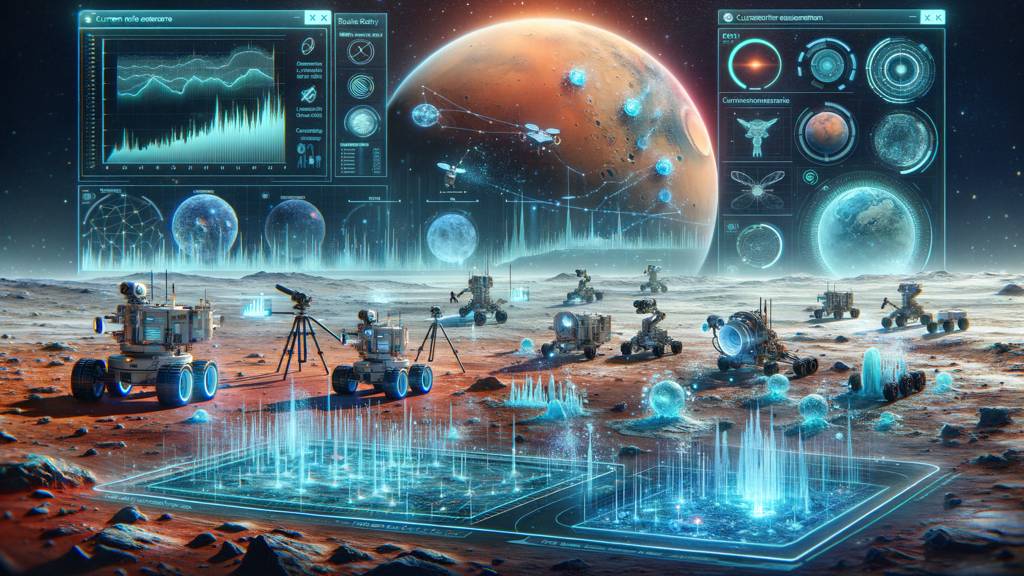Understanding the Role of Ice in Mars' Climate with Mars-Ice.org
Mars-Ice.org is a collaborative consortium dedicated to unraveling the mysteries of Martian ice and its profound impact on the Red Planet's climate. This organization brings together scientists, researchers, and enthusiasts from around the globe to explore how ice influences Martian weather patterns, surface conditions, and potential habitability. By leveraging cutting-edge technology and innovative research methods, Mars-Ice.org aims to deepen our understanding of Mars' icy landscapes.
The Importance of Ice in Mars' Climate
Ice plays a pivotal role in shaping the climate of Mars. Unlike Earth, where water exists abundantly in liquid form, Martian water is predominantly trapped as ice at the poles and beneath the surface. This frozen reservoir not only holds clues about Mars' climatic history but also serves as a critical component in its current weather systems. Seasonal changes cause polar ice caps to expand and contract, affecting atmospheric pressure and wind patterns.
The sublimation of carbon dioxide ice during Martian summers leads to dramatic shifts in atmospheric dynamics. These changes can influence dust storms—one of the most notable features of Martian weather. Understanding these processes is crucial for predicting future climate scenarios on Mars, especially if human exploration becomes a reality.
Moreover, studying Martian ice provides insights into potential life-supporting environments. If liquid water once existed or still exists beneath the surface, it could have harbored microbial life. Thus, exploring these icy regions is essential for astrobiology.
Current Research on Martian Ice

Mars-Ice.org spearheads various research initiatives aimed at unlocking the secrets of Martian ice. Recent studies have focused on analyzing data from orbiters like NASA's Mars Reconnaissance Orbiter (MRO) and ESA's Mars Express. These spacecraft provide high-resolution images and spectral data that help identify different types of ice deposits.
One groundbreaking discovery involves subglacial lakes potentially existing beneath the south polar cap. Detected through radar sounding techniques, these lakes suggest that liquid water might persist under certain conditions—a tantalizing prospect for scientists searching for extraterrestrial life.
Additionally, researchers are investigating the isotopic composition of ice to reconstruct past climate variations on Mars. By examining layers within polar caps, scientists can infer historical atmospheric changes over millions of years—a task akin to studying Earth's own ice cores.
Technological Tools and Methods Used by Mars-Ice.org
To achieve their ambitious goals, Mars-Ice.org employs an array of technological tools and methods designed specifically for studying icy terrains on another planet. Remote sensing instruments onboard orbiters provide invaluable data about surface composition and topography.
- Radar sounders penetrate beneath the surface layers to detect hidden ice deposits.
- Spectrometers analyze reflected sunlight to determine mineral compositions.
- High-resolution cameras capture detailed images that reveal geological features indicative of past glacial activity.
These technologies are complemented by computer models simulating climate interactions between atmosphere and cryosphere (the frozen part). By integrating observational data with simulations, researchers gain comprehensive insights into how ice influences broader climatic patterns across time scales.
| Instrument | Function |
|---|---|
| Radar Sounders | Detect sub-surface structures like buried glaciers |
| Spectrometers | Analyze mineral content |
| High-Resolution Cameras | Capture detailed imagery |
Challenges in Studying Martian Ice
Despite significant advancements made by organizations like Mars-Ice.org, several challenges persist when it comes to studying Martian ice comprehensively:
-
Distance Accessibility: The sheer distance between Earth and Mars complicates direct exploration efforts; robotic missions must suffice until human presence becomes feasible.
-
Harsh Conditions: Extreme temperatures pose risks not only during landing but also while operating sensitive equipment over extended periods.
-
Data Limitations: Although remote sensing provides valuable information about surface characteristics or subsurface structures indirectly inferred through radar echoes or spectral signatures—ground truth validation remains challenging without physical samples returned from missions yet-to-be-launched!
-
Resource Constraints: Funding limitations often restrict long-term projects requiring sustained investment beyond initial phases—necessitating collaboration among international space agencies sharing common objectives!
Future Prospects for Mars Climate Research
Looking ahead towards future prospects within this field holds immense promise driven largely by upcoming mission plans involving both robotic explorers sent forth from Earth alongside eventual human settlers arriving sometime mid-century!
NASA's Perseverance rover currently traverses Jezero Crater—a site believed once teeming with liquid water billions years ago—equipped sophisticated instruments capable detecting biosignatures indicative past microbial life forms potentially preserved within ancient sediments now frozen solid under present-day conditions!
Meanwhile private enterprises such SpaceX continue developing reusable rockets intended ferry astronauts directly onto surface facilitating hands-on investigations previously unimaginable just decade prior! As these efforts progress further into 2030s onwards expect increasing collaboration amongst global partners working together achieve common goal understanding fully what lies beneath enigmatic exterior awaits discovery beyond horizon today!